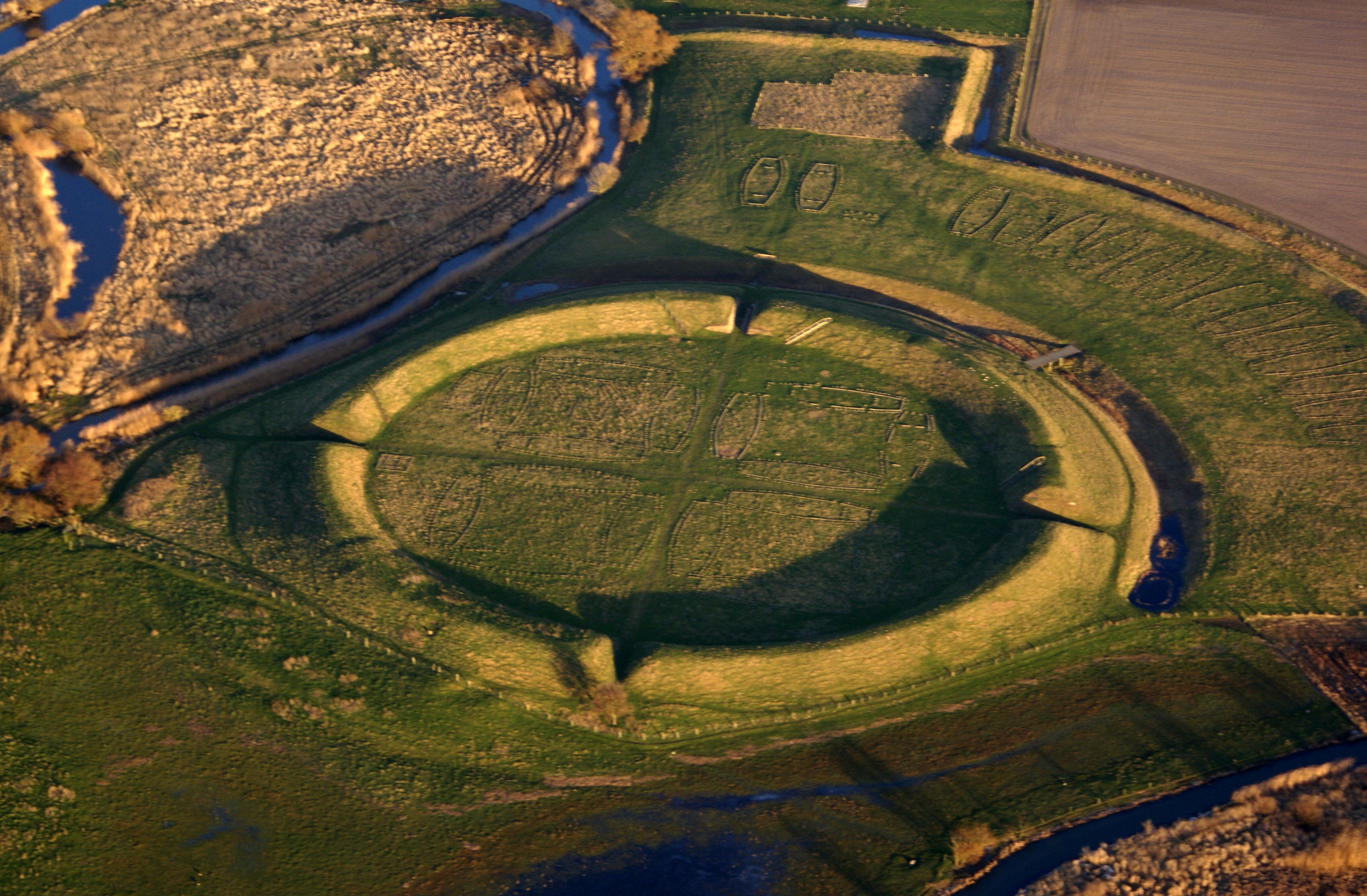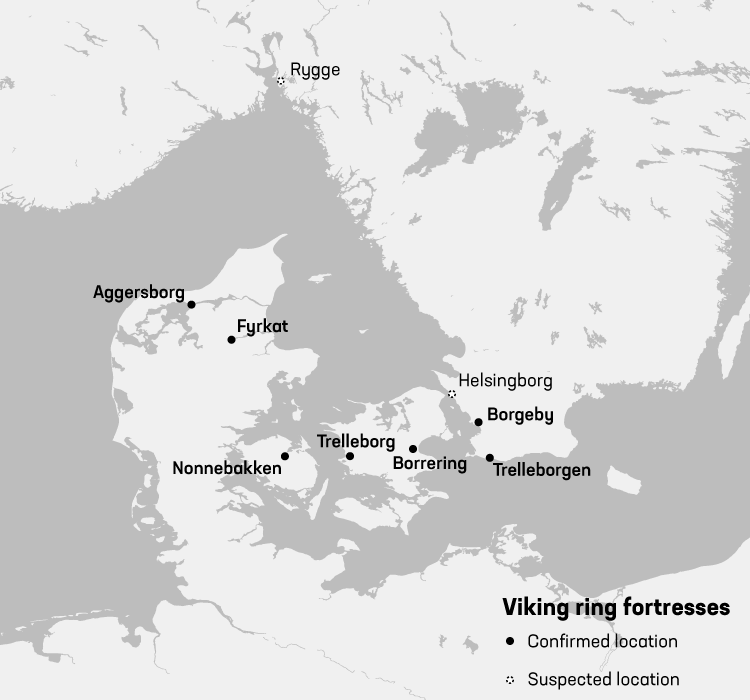Ring Castle on:
[Wikipedia]
[Google]
[Amazon]
 A Viking ring fortress, or Trelleborg-type fortress, is a type of
A Viking ring fortress, or Trelleborg-type fortress, is a type of
 Similar structures have been found throughout
Similar structures have been found throughout
 Confirmed
* Aggersborg near Aggersund, Denmark.
*
Confirmed
* Aggersborg near Aggersund, Denmark.
*
Viking Empires
'. 1st. ed. Cambridge: Cambridge University Press, 2005 p. 180. Datings by
File:Fyrkat-2.jpg, alt=, Aerial image of Fyrkat.
File:Hallbyggnaden i Fyrkat 2.JPG, alt=, Recreation of a typical building at Fyrkat.
File:Trelleborgen2.jpg, alt=, Recreation of the fortress walls at Trelleborg.
circular fort
A circular rampart (German: ''Ringwall'') is an embankment built in the shape of a circle that was used as part of the defences for a military fortification, hill fort or refuge, or was built for religious purposes or as a place of gathering.
The ...
of a special design, built in Scandinavia during the Viking Age. Collectively, they may also be known as trelleborgs. These fortresses have a strictly circular shape, with roads and gates pointing in the four cardinal directions. They are sometimes partially encircled by advanced ramparts, though not always circular.
There are a total of seven known Viking ring fortresses at present, located in Denmark and Scania, Sweden
Sweden, formally the Kingdom of Sweden,The United Nations Group of Experts on Geographical Names states that the country's formal name is the Kingdom of SwedenUNGEGN World Geographical Names, Sweden./ref> is a Nordic country located on ...
. Many of them have been dated to the reign of Harold Bluetooth of Denmark, c. 980. Their exact purpose is subject to debate.Etymology
This specific type of fortification was named after the first discovered example: Trelleborg nearSlagelse
Slagelse () is a town on Zealand, Denmark. The town is the seat of Slagelse Municipality, and is the biggest town of the municipality. It is located 15 km east of Korsør, 16 km north-east of Skælskør, 33 km south-east of Kalundborg and 14 km ...
, excavated in the years 1936–1941. Traditionally, the name ''trelleborg'' has been translated and explained as ″a fortress built by slaves″, since the Old Norse word for slave was '' thrall'' (The modern word is '' træl'' in Danish and ''träl'' in Swedish) and ''borg'' means fortress or city. The word ''trel'' (pl. ''trelle'') is also a plausible explanation and relates to the wooden staves, covering both sides of the protective circular walls.
History
Around 974 the Danish Viking king Harald Bluetooth lost control of the Danevirke and parts of Southern Jutland to the Saxons. The entire complex of fortifications, bridges and roads which were built around 980 are presumed by some to be Harald's work, and part of a larger defensive system. Fortifications of a similar design and date have been found around other old towns in Scandinavia, like inAarhus
Aarhus (, , ; officially spelled Århus from 1948 until 1 January 2011) is the second-largest city in Denmark and the seat of Aarhus Municipality. It is located on the eastern shore of Jutland in the Kattegat sea and approximately northwest ...
for example, but they lack the perfect circular geometry of the distinct ring fortresses. Most of the fortresses have been dated to the reign of Harald Bluetooth, which lasted from c. 958 until 986. The fort in Borgeby, however, has been dated to c. 1000, though as the precise date is undetermined, it is possible that it was also constructed as part of his fortification push.
The precise purpose of the fortresses, however, is unknown. Some historians argue that they functioned as military barracks or training grounds by Sweyn Forkbeard
Sweyn Forkbeard ( non, Sveinn Haraldsson tjúguskegg ; da, Svend Tveskæg; 17 April 963 – 3 February 1014) was King of Denmark from 986 to 1014, also at times King of the English and King of Norway. He was the father of King Harald II of D ...
. However, it is more likely that they were intended as defensive strongholds along strategic trade points and/or administrative outposts of the budding state. Soren Sindbæk has offered the hypothesis that the fortresses allowed local populations to seek shelter within the fortress walls against an enemy while waiting for assistance from friendly forces from afar; this means that the fortresses helped Harald Bluetooth to control vast territory and send his army to a particular part of his territory without worrying that the undefended parts would be conquered or plundered. Others have debated whether the fortresses were defensive structures, military strongholds, or primarily served as barracks, as well as the economic, religious, and symbolic significance of the fortresses.
Many of the fortresses were abandoned by the end of the Viking Era. Several were enveloped by other settlements, such as Nonnebakken which now lies underneath Odense, and Trelleborgen under the city of Trelleborg. Others, were forgotten and receded into the landscape. The modern rediscovery of these sites began in the 1930s, with the excavation of Trelleborg. Since then, a total of seven sites have been officially recognised at Viking ring fortresses. A possible eighth site in Helsingborg was suggested in 2009 after archaeological excavations since 1987. The Helsingborg ring fort might have been the largest of them all, at a diameter of 270 m. Another site in Rygge has also been proposed, but not confirmed.
 Similar structures have been found throughout
Similar structures have been found throughout Northern Europe
The northern region of Europe has several definitions. A restrictive definition may describe Northern Europe as being roughly north of the southern coast of the Baltic Sea, which is about 54th parallel north, 54°N, or may be based on other g ...
, particularly in Ireland, but none of them have the same strict and precise geometrical design of the Scandinavian ring fortresses. On the coasts of the Netherlands and Belgium there are ring castles with certain points of resemblance. On the island Walcheren, for example, there are the remnants of a castle with gateways in the four points of the compass, combined with streets. Similar forts can be found in England, such as Warham Camp
Warham Camp is an Iron Age circular hill fort with a diameter of near Warham, south of Wells-next-the-Sea in Norfolk. It is a Scheduled Monument and a biological Site of Special Scientific Interest. It is in the Norfolk Coast Area of Outstand ...
. These generally date though from around the time of the Roman conquest of Celtic Britain and had been lying in ruins for hundreds of years prior to the building of the Viking ring forts.
Denmark and Sweden are currently applying for admission of the Viking ring fortresses as UNESCO World Heritage sites.
List of viking ring fortresses
 Confirmed
* Aggersborg near Aggersund, Denmark.
*
Confirmed
* Aggersborg near Aggersund, Denmark.
* Borgeby
Borgeby Castle ( sv, Borgeby slott) lies in Lomma Municipality, Scania in southern Sweden, beside the Kävlingeån, the largest river in Scania.
History
The castle is built on the site of an 11th-century castle or fortress. Finds at the site m ...
north of Lund
Lund (, , ) is a city in the southern Swedish provinces of Sweden, province of Scania, across the Øresund, Öresund strait from Copenhagen. The town had 91,940 inhabitants out of a municipal total of 121,510 . It is the seat of Lund Municipali ...
in Scania, Sweden
Sweden, formally the Kingdom of Sweden,The United Nations Group of Experts on Geographical Names states that the country's formal name is the Kingdom of SwedenUNGEGN World Geographical Names, Sweden./ref> is a Nordic country located on ...
.
* Borrering Official name is Borgring
BorreringAnders Petersen: ''Vallø og Omegn. En historisk Skildring'', Copenhagen, 1877. (p. 252) n Danish/ref>Harald Andersen: "De glemte borge" in Skalk, 1992, No. 1, p. 19-30 n Danish/ref> (1682: ''Borre Ring''; 1877 ...
near Køge, Denmark.
* Fyrkat near Hobro, Denmark.
* Nonnebakken in Odense, Denmark.
* Trelleborg near Slagelse
Slagelse () is a town on Zealand, Denmark. The town is the seat of Slagelse Municipality, and is the biggest town of the municipality. It is located 15 km east of Korsør, 16 km north-east of Skælskør, 33 km south-east of Kalundborg and 14 km ...
, Denmark.
* Trelleborgen in Trelleborg, Scania, Sweden
Sweden, formally the Kingdom of Sweden,The United Nations Group of Experts on Geographical Names states that the country's formal name is the Kingdom of SwedenUNGEGN World Geographical Names, Sweden./ref> is a Nordic country located on ...
.
Suspected
* Helsingborg in Scania, Sweden
Sweden, formally the Kingdom of Sweden,The United Nations Group of Experts on Geographical Names states that the country's formal name is the Kingdom of SwedenUNGEGN World Geographical Names, Sweden./ref> is a Nordic country located on ...
.
* Rygge () in Østfold, Norway.
Comparison of the seven fortifications
The viking ring fortresses differ clearly from others types of fortifications from the Viking Age. Unlike other circular forts from the period, the ring fortresses which follow the Trelleborg model are constructed after a strictly geometrical plan and measured with the Roman foot. The pointed bottoms of themoat
A moat is a deep, broad ditch, either dry or filled with water, that is dug and surrounds a castle, fortification, building or town, historically to provide it with a preliminary line of defence. In some places moats evolved into more extensive ...
s is another element borrowed from the Ancient Romans. All of such fortresses had similar designs, "perfectly circular with gates opening to the four corners of the earth, and a courtyard divided into four areas which held large houses set in a square pattern."A. Forte, R. Oram, and F. Pederson. Viking Empires
'. 1st. ed. Cambridge: Cambridge University Press, 2005 p. 180. Datings by
dendrochronology
Dendrochronology (or tree-ring dating) is the scientific method of dating tree rings (also called growth rings) to the exact year they were formed. As well as dating them, this can give data for dendroclimatology, the study of climate and atmos ...
have found the wood used for the construction of Trelleborg to have been felled in the autumn of 980 and thus being used for building presumedly in the spring of 981. The rather short construction time and the complete lack of any signs of maintenance indicate an only short use of the buildings, maybe five years but hardly more than twenty. The others have been dated to roughly the same time. Fyrkat may be a little older, Aggersborg somewhat younger. Not enough has been found at the other sites for a precise dating but the construction and layout of the ''trelleborgs'' at Slagelse, Fyrkat, Aggersborg, Nonnebakken under Odense and the fort under modern Trelleborg in Sweden is so similar that it is believed most probable that they were conceived by a single mind.
Gallery
See also
* Circular rampart *Ringfort
Ringforts, ring forts or ring fortresses are circular fortified settlements that were mostly built during the Bronze Age up to about the year 1000. They are found in Northern Europe, especially in Ireland. There are also many in South Wales ...
* Ravning Bridge, a contemporary large-scale structure in Denmark.
References
{{Authority control Forts in Denmark Germanic archaeological artifacts Buildings and structures completed in the 10th centuryViking ring fortresses
Vikings ; non, víkingr is the modern name given to seafaring people originally from Scandinavia (present-day Denmark, Norway and Sweden),
who from the late 8th to the late 11th centuries raided, pirated, traded and ...
10th-century fortifications